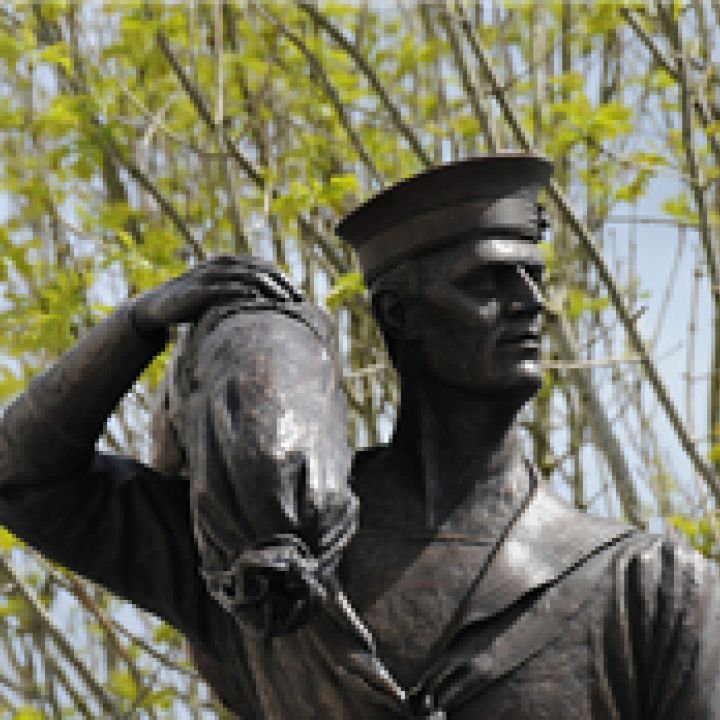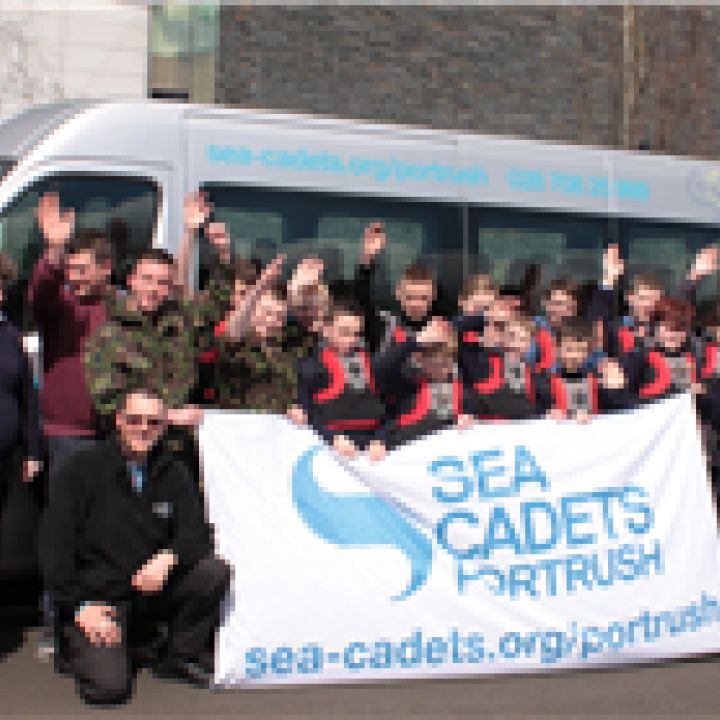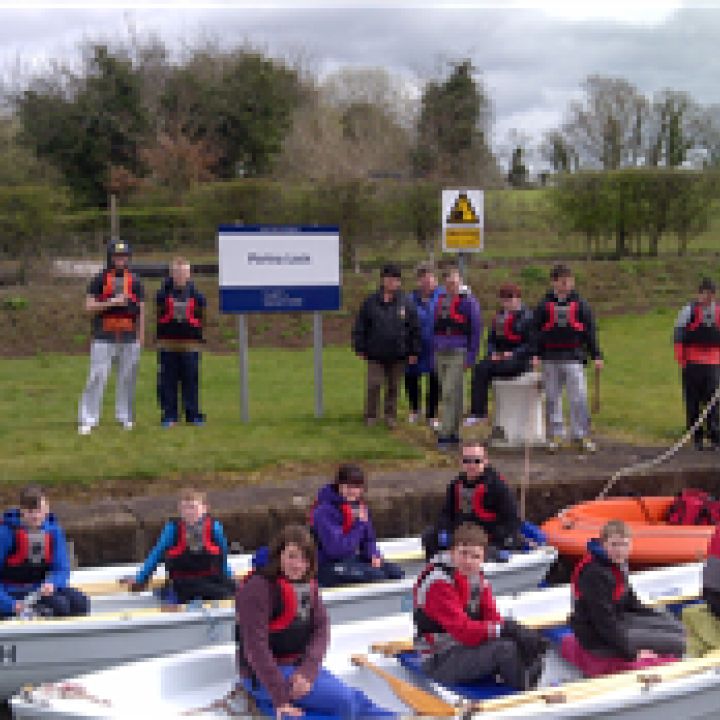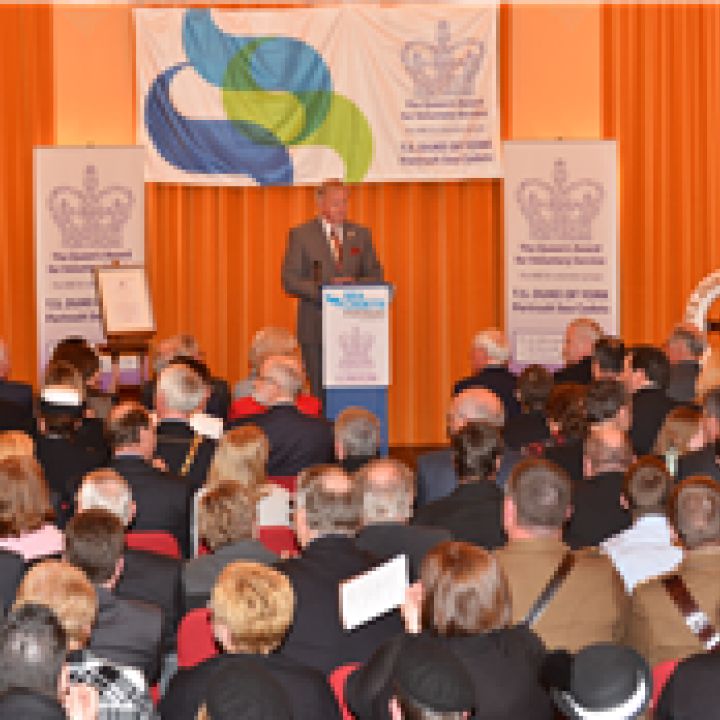T.S. DUKE OF YORK, Portrush Sea Cadets and their visitors - the Royal Canadian Sea Cadet Corps of the Canadian Northwest Prairie Cadets, took part in the unveiling ceremony and commemoration of the 70th. Anniversary of the Battle of Atlantic in Londonderry - Saturday and Sunday, 11th. and 12th. May 2013.
The International Sailor statue, a replica of the Mariner sculpture statue in Halifax, Nova Scotia in Canada - of a sailor carrying his hammock on his right shoulder and kit bag in his left hand. There is no naval insignia, as the statue is intended to reflect the contribution of the seamen from the many Allied nations which protected the shipping convoys during the war. Originally created by the distinguished Canadian sculptor Peter Bustin, the replica statue was cast at the Tanat Foundry, Oswestry. The International Sailor statue stands on a plinth of local granite.
Written at the side of a poppy by one of the Royal Canadian Sea Cadet Corps of the Canadian Northwest Prairie Cadets, her feelings and experience of the 70th. Anniversary and Commemoration of The Battle of Atlantic at Londonderry
“Battle of the Atlantic Sunday! Mothers day? (I forgot), this was the most amazing experience of my life. I was so honoured and proud to represent our country. we did great. I loved how dedicated these people are to remembering! These people should be so proud of everything they have done. I can't even begin to describe it. I loved it. I loved the rain, the parade the veterans, everything. I'm so glad we came.”
The location of the statue at Ebrington is intended to reflect the vital role which the barracks played as a naval base as part of the HMS Ferret complex.
Unveiled on Saturday, 11th. May 2013 at Ebrington, Londonderry, by HRH Prince Michael of Kent, G.C.V.O., K.St.J., Commodore-in-Chief of the combined Maritime Reserve. HRH Prince Michael of Kent, was in Londonderry to pay tribute to the 66,000 Allied merchant seamen, sailors and airmen lost in the Battle of the Atlantic, HRH Prince Michael of Kent joined World War II veterans and merchant seamen from a host of nations, Sea Cadets from throughout Northern Ireland, Royal Canadian Sea Cadet Corps of the Canadian Northwest Prairie Cadets and the Sea Cadets of the CCF of Foyle College - all in the city to mark the 70th anniversary of the ‘Turning of the Tide’ in the Battle of the Atlantic.
After a special remembrance service, held at St Columb’s Cathedral, HRH Prince Michael of Kent laid a wreath at the Diamond War Memorial on Sunday , 12th. May 2013, to mark the city’s unique contribution to the Battle of the Atlantic. At the height of the raging sea conflict, Londonderry was host to up to 20,000 Royal Navy personnel, 10,000 Canadian and Newfoundlanders, more than 6,000 US personnel as well as many from the German occupied nations.
With the outbreak of the Second World War and the start of the Battle of the Atlantic, the Admiralty decided to develop a large new naval base in Northern Ireland to serve as a centre for convoy escorts, providing repair and refuelling facilities. Derry was selected as a prime location due to Londonderry Port being the UK's most westerly anchorage, it provided the fastest access into the Atlantic. Royal Navy warships could then quickly come to the aid of convoys under attack by German U-boats, and help escort the convoys in and out of British ports.
The old Ebrington Barracks were taken over by the navy and commissioned on 9th. December 1940 as HMS Ferret. The shipyard at Pennyburn was also taken over as "Fort George", and used as a ship repair facility, manned by workers from the Harland and Wolff yards at Belfast. Ships based at FERRET were under the control of Western Approaches Command, located in Plymouth for the early part of the war. The main headquarters for the Western Approaches Command was moved to Liverpool in February 1941 as the North Western Approaches became the most vital area of convoy activity. FERRET was then the backup for the Liverpool headquarters, with the other main bases in the area being at Greenock, and later at Belfast.
The organisational function of FERRET was to form escort groups of the warships based there, mostly small destroyers, frigates, corvettes and armed trawlers. From the 1st. February 1941 these craft had a separate accounting system from the main base. By 1942 this system had been extended to handle the accounts of Royal Navy ships based at St' John's, Newfoundland and the Port of Argentia as one the finest in Atlantic Canada, its sheltered, deep-water facility is over 3 kilometres in length with a wide turning basin, Argentia’s most important attribute is the year around, ice-free access.. A Coastal Forces base was established in April 1941, under the name HMS FERRET II.
Eventually, over twenty thousand allied troops and sailors had passed through HMS FERRET, and the base had been home to over two hundred ships of the Royal Navy, US Navy and the Royal Canadian Navy, as well as ships from the Free French and Free Dutch naval forces and some ships of the Royal Indian Marine. There was a debate over the future of the base, but the Admiralty decided to retain the property, converting it into a proper school for anti-submarine warfare training. There had been plans to commission the establishment under the name HMS Phoenix, this was changed in preference to HMS Sea Eagle. Ferret was paid off on 21st. July 1947, and HMS Sea Eagle commissioned that same day.
H.M.S Sea Eagle operated as the Joint Anti-Submarine School until 1970, when it was re-named again as Ebrington Barracks. The base was closed by the Ministry of Defence in 2004. The ILEX Urban Regeneration Company was tasked with the refurbishment of this site as well as Fort George on the Strand Road and Clooney Naval Base site in the Waterside.
LIVE THE ADVENTURE . . . . . . . JOIN SEA CADETS PORTRUSH
16, Dunluce Avenue, Portrush, BT56 8DW
Web-site:
sea-cadets.org/portrush
Telephone:
028 708 25 999
E-mail:
portrushseacadets@btconnect.com
Unit open:
Every Monday and Thursday 19:00 - 21:30






